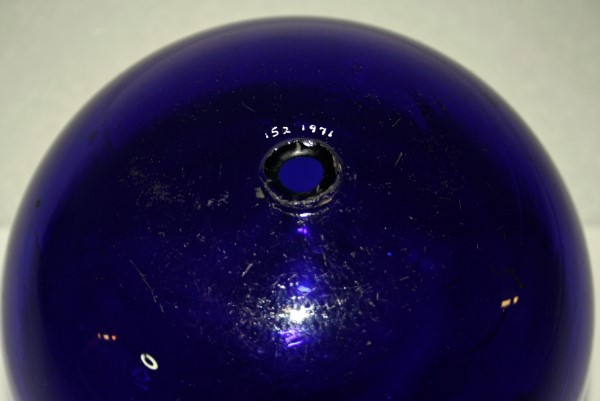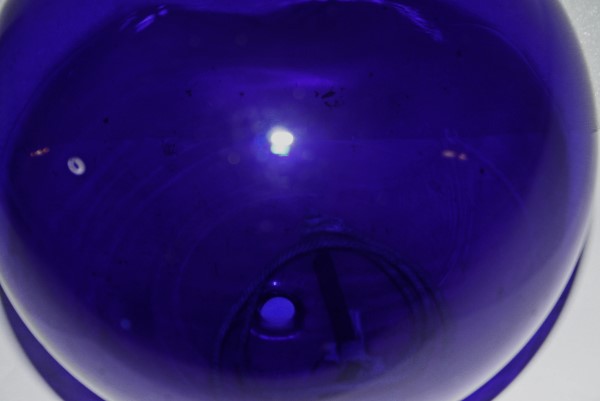c. 1800
Liathróid Cailligh
A brightly coloured glass sphere, of the type often hung in the windows of homes in England in the 18th Century to ward off evil spirits and witches.
By Nuala Doherty
Description from Museum Register
Blue glass ball. “Fine old Sapphire-blue glass witch ball. These used to be suspended from ceilings, and were supposed to ward off evil spirits and witches. English c.1800”. Height 15.8cm.
Where did it come from?
The ball was originally part of the personal collection of Harry Percival Swan of Buncrana, Co. Donegal. Swan bequeathed his collection to the Royal Irish Academy, who transferred it to the National Museum of Ireland in 1971.
What is a ‘witch ball’?
A witch ball is a brightly coloured glass sphere, often hung in the windows of homes in England in the 18th Century, though they still enjoy some popularity today. The exact provenance of this ball is unknown; however glass pieces of this nature were often produced in Nailsea, Somerset around this time. The Oxford Dictionary of English Folklore states that their purpose was to “attract and neutralise the evil eye of a passing witch, either by reflecting it back upon her or by puzzling her with the pattern”. The belief at the time was that the bright colours of the ball, after enticing the witch and possibly other, darker, spirits, would trap them inside it and thus protect the home from such negativity. Witch balls also gained popularity among the settlers of New England, who sometimes filled them with holy water for added protection. They were not, however, commonly used in Ireland, though similar traditions did exist in rural areas, where herbs such as rosemary were tied in ribbon and hung over a front door to protect the house.
Historically, belief in witches and their powers differed between Ireland and Britain. In England around the time this ball was manufactured, witchcraft was viewed as an evil doing, and was punishable by law. The Witchcraft Act of 1735 brought with it penalties for any person who claimed to have the power to engage with spirits or to foretell the future. In the eyes of the law, they were regarded as con artists and subjected to fines and imprisonment. However the fact that this ball was produced in England in1800 serves to show that some people, despite its dismissal by the British Parliament, still believed in the power of witches and their ability to bring bad fortune upon them.

Fig. 2: Witch Ball close-up
In Ireland, witches were more commonly known as “wise women” or “fairy doctors”, and rather than being demonised, were often regarded as important members of a community. Their knowledge of so-called “cures” through herbal remedies, as well as what was assumed to be their heightened sense of intuition, meant that they often acted as doctors, midwives and advisors in areas where little formal medicine existed. It was considered unwise to cross them, as a person would risk possible misfortune and, as a result, this granted the wise woman a relatively high status in the local community. A well known example of this was the “wise woman of Clare”, Biddy Early, whose reputation as a healer meant that she had a steady flow of visitors to her home throughout her life, all seeking her help and guidance. Unfortunately there are instances where other women were not so fortunate, such as the tragic case of Bridget Cleary in Co. Tipperary. In 1895, Cleary was killed by her husband, in the company of other family members, as they had become convinced that she had been overcome by a dark spirit. Thankfully, these instances were very rare, but nonetheless form part of Ireland’s long and sometimes complicated history of folk tales, religion and witchcraft.

Fig. 3: Witch Ball close-up
This ball has a piece of string inside which is attached to a small twig, allowing it to be hung safely. We have little information of its past or how it came into the possession of its collector. It is in excellent condition. In the 18th century, some people who displayed witch balls believed that, rather than enticing witches, the witches themselves help to enchant these balls in order to entrap the more sinister spirits inside them. There is no way of knowing what has been captured in our own witch ball, but one might like to believe that it is helping to protect our glass collection, among which it sits on display in Collins Barracks!
Learn more…
-
Simpson, J. and Roud, S. Oxford Dictionary of English Folklore. Oxford University Press, 2003.
-
Curran, B. A Bewitched Land; Ireland’s Witches. The O’Brien Press, Dublin, 2005.
-
The Tarpon Springs Writers Group. The Spindrift Anthology. Savage Press, Florida, 2000.
With thanks to Edyta Slomka and Brenda Malone for help with photography.
Location:
Liathróid Cailligh is located at:
In Storage
Previous artefact:
Lead-Bearing Minerals from Glendalough
Next artefact:
